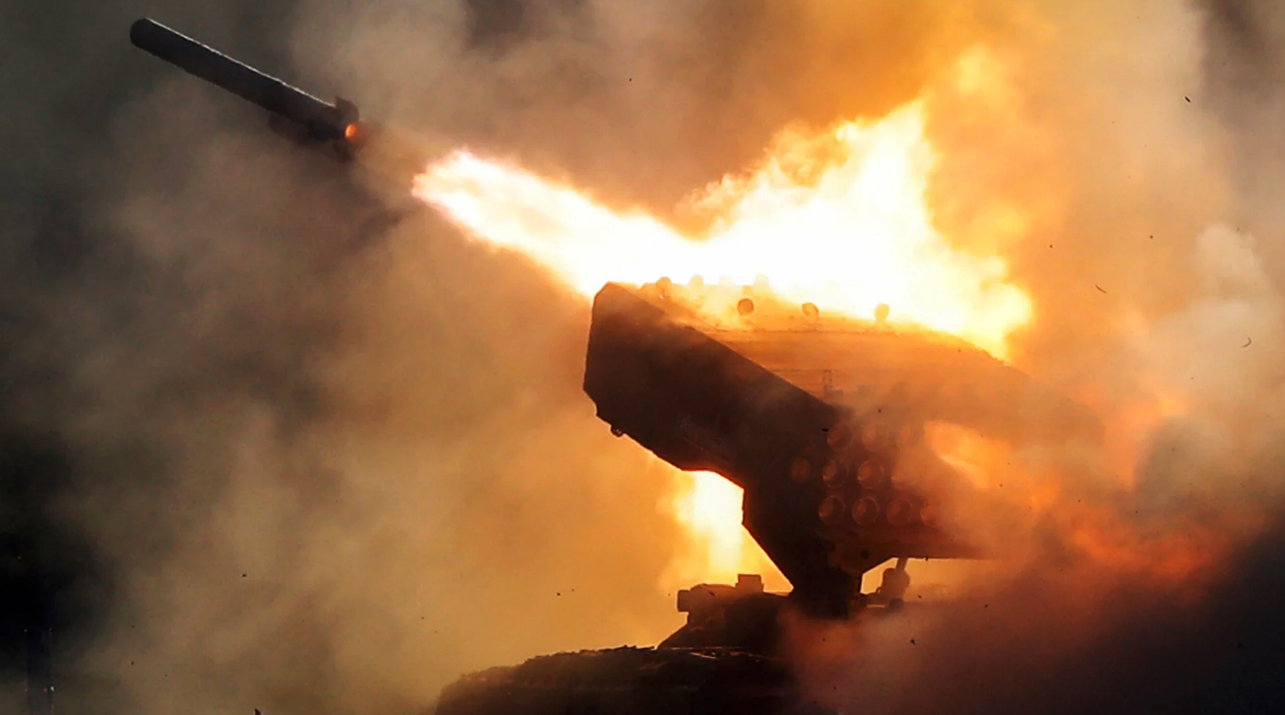Videos have surfaced showing the terrifying detonation of what are likely rounds from Russia’s TOS-1A multiple launch rocket system (MLRS) during an attack in Ukraine. The clips may serve as some of the first recorded footage of the TOS-1A Solntsepek, or Sunshine, striking Ukrainian positions.
The blasts are said to have occurred near Novomykhailivka and Lyman, both in the Donetsk region in Donbas. In the footage, the massive shockwaves that the thermobaric rounds cause can clearly be seen, with multiple explosions occurring at once during the attack. The phenomenon you are seeing, which thermobaric weapons are especially prone to produce, is called a condensation cloud, or Wilson cloud. A sufficiently large explosion in high-humidity conditions like those that we appear to see in the video will cause a drop in density in the air around it, which in turn temporarily cools the air and causes some of the water vapor therein to condense. This creates the ominous bubble-like clouds seen in the clip.
The TOS-1A system is a variant of the TOS-1 that dates back to the late Cold War. The TOS-1A entered service in 2001 with an improved range and an upgraded ballistic computer, among other refinements. First used by the Russian Army in Chechnya, the complete system is mounted on a modified T-72 tank chassis and was originally designed for indirect fire support of advancing infantry units and main battle tanks. The vehicle is fitted with a rotating launch system capable of holding up to 24 unguided thermobaric rockets, which can be launched within six to 12 seconds. You can find a more detailed description of the TOS-1A and its history in a past War Zone piece by clicking here.
The TOS-1A’s rockets use thermobaric, or fuel-air explosive, warheads. These use surrounding oxygen to create a high-temperature explosion. The devastating weapons, also sometimes referred to as ‘vacuum bombs,’ include a fuel container with two separate explosive charges.

Once the target is hit, the first explosive charge allows the fuel container to open and disperse a cloud of fuel, and the second charge ignites the incendiary fuel cloud which results in the fiery explosion and a subsequent oxygen-sucking vacuum. The detonation of the rockets causes such a rapid and drastic change in air pressure that taking shelter within a trench or cave, behind a reinforced barrier, or, in some cases, even inside of an armored vehicle would fail to protect a human.
As mentioned in The War Zone’s feature linked above, “The primary … effect [created by the TOS-1’s rockets] is a long-duration high-pressure blast wave which creates a vacuum – then precipitates a reverse wave,” according to the 2011 edition of U.S. Army Training and Doctrine Command’s (TRADOC) unclassified World Equipment Guide (WEG). “These pressure/vacuum surges (up to 427 pounds per sq inch) cause a ripping effect on soft materials (such as airplane skin, radar surface, human lung tissue). Walls and surfaces within the affected area do not necessarily shield victims, rather cause multiple pressure waves, which amplify the tearing effects and can topple structures.”

“A secondary effect is high-temperature heat — 2,500-3,000° C. An incomplete explosion renders a near-devastating effect, wide-area long-duration high-temperature flame,” it continues. “Even those outside of the blast area will be rendered ineffective with debilitating mental and physical trauma.”
Why Russia would need to employ such a destructive weapon could be explained by the fact that the TOS-1A is generally described as being useful for uprooting well dug-in forces. There have been reports that Ukrainian units are making use of structures and trench lines in their defense in the Donbas region, so a weapon like this could prove to be pivotal in breaking those kinds of hardened defenses.
However, multiple claims have emerged following this recent development that deems Russia’s use of the TOS-1A as a war crime, but there are no specific international laws that ban the use of these rockets in general combat. The politics behind the system’s employment, however, do start to become murky if they are pointedly used against established civilian populations. If the ethics of this attack are to later come into question, it wouldn’t necessarily be the nature of the weapon that would be at issue, but its employment.

Ukrainian groups have captured a number of TOS-1As throughout the conflict with Russia, along with some of the dedicated reloading vehicles for the system. But, as the recent videos demonstrate, the TOS-1A remains in Russian hands and in significant numbers.
This footage acts as a chilling reminder of what the TOS-1A is capable of — creating extreme heat and pressures that can do incredible harm to humans nearby.
Contact the author: Emma@thewarzone.com
